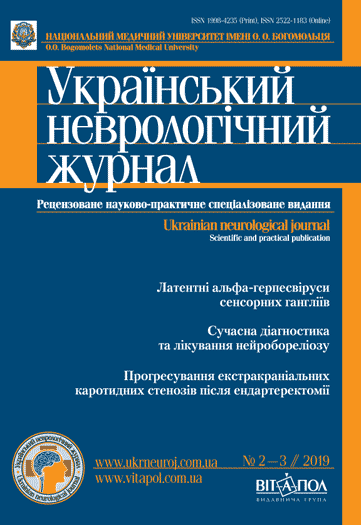Патологічні зміни головного мозку мишей на тлі моделювання ішемії з асоційованою вірусною інфекцією
DOI:
https://doi.org/10.30978/UNJ2019-2-57Ключові слова:
кора головного мозку мишей, атеросклероз, жирова дієта, герпетична інфекція, ішемізаціяАнотація
Мета — експериментально дослідити структурні зміни кори головного мозку мишей при використанні жирової дієти (ЖД), зараженні герпетичною інфекцією та ішемізації.
Матеріали і методи. У дослідженні використано 194 тварини (миші лінії Balb/c). У серіях послідовних експериментів сформовано 7 груп: 1‑ша (n = 52) — ЖД з холестерином, 2‑га (n = 30, померли 7 тварин) — зараження вірусом простого герпесу 1 типу (ВПГ‑1), 3‑тя (n = 30) — однобічна оклюзія загальної сонної артерії (ОЗСА), 4‑та (n = 20, померли 10 тварин) — зараження ВПГ‑1 та ОЗСА, 5‑та (n = 5) — зараження ВПГ‑1 та використання ЖД, 6‑та (n = 16, померли 10 тварин) — зараження ВПГ‑1, ОЗСА та використання ЖД, група додаткового контролю — інтактні тварини (n = 5). Здійснено морфометричну оцінку мікропрепаратів для визначення щільності нейронів неокортекса з дегенеративними змінами та без них тім’яної та скроневої ділянок кори головного мозку та гіпокампа.
Результати. Морфометричний аналіз мікропрепаратів дав змогу виділити основні зони та анатомічні утворення мозку, які зазнали пошкодження в експериментальних моделях. Зміни виявлено переважно у неокортексі тім’яної та скроневої ділянок кори головного мозку та гіпокампі. Для оцінки типу пошкодження мозку нейронів виділено вогнищеві та дифузні зміни. Зроблено спробу оцінити динаміку змін щільності нейронів із ознаками дегенерації та без них у тім’яній та/або скроневій ділянках кори головного мозку лабораторних тварин при використанні ЖД, інфікуванні ВПГ‑1 та ОЗСА.
Висновки. На основі даних мікроскопічного дослідження скроневої та/або тім’яної ділянок кори головного мозку лабораторних тварин установлено, що поєднання таких чинників, як ЖД, нейроінфекція та ішемізація, спричинило збільшення щільності нейронів з ознаками дегенерації та вплинуло на динаміку їх утворення. За результатами морфометричного дослідження кори головного мозку лабораторних мишей виявлено статистично значуще збільшення ішемічного пошкодження нейронів: у разі інфікування ВПГ‑1 та використання ЖД — локального характеру, у разі ОЗСА — дифузного характеру. Збільшення ступеня пошкодження неокортекса при ішемізації головного мозку мишей із герпетичною інфекцією та використанням ЖД свідчить про можливий зв’язок між ними.
Посилання
Avdeeva MV, Samoilova IG, Shcheglov LS. Pathogenetic aspects of the relationship of infectious diseases of the oral cavity with the development and progression of atherosclerosis and the possibility their complex prevention. Journal of infectology. 2012;3:30-34.
Turchyna NS, Savosko SI. The study of the initial stages of atherogenesis against the background of high-fat diet]. Fiziolohichnyi zhurnal. 2018;2:54-64.
Alber DG, Powell KL, Vallance P et al. Herpesvirus infection accelerates atherosclerosis in the apolipoprotein E-deficient mouse. Circulation. 2000;N 7:779-785.
Alber DG, Vallance P, Powell KL. Enhanced atherogenesis is not an obligatory response to systemic herpesvirus infection in the apoE-deficient mouse: comparison of murine gamma-herpesvirus-68 and herpes simplex virus-1. Arteriosclerosis, Thrombosis, and Vascular Biology. 2002;22(5):793-798.
Al-Ghamdi A. Role of herpes simplex virus-1, cytomegalovirus and Epstein-Barr virus in atherosclerosis. Pakistan Journal of Pharmaceutical Sciences. 2012;25(1):89-97.
Chirathaworn C, Pongpanich A, Poovorawan Y. Herpes simplex virus 1 induced LOX-1 expression in an endothelial cell line, ECV 304. Viral Immunology. 2004;17(2):308-314.
Chiu B, Viira E, Tucker W, Fong IW. Chlamydia pneumoniae, cytomegalovirus, and herpes simplex virus in atherosclerosis of the carotid artery. Circulation. 1997;96(7):2144-2148.
Fabricant CG, Fabricant J, Litrenta MM, Minick CR. Virus-induced atherosclerosis. The Journal of Experimental Medicine. 1978;1:335-340.
Febbraio M, Silverstein RL. CD36: implications in cardiovascular disease. The International Journal of Biochemistry & Cell Biology. 2007;39(11):2012-2030.
Gumenyuk АV, Motorna NV, Rybalko SL et al. Development of herpetic infection associated with stroke and its correction with acyclovir. Current Issues in Pharmacy and Medical Sciences. 2017;30(1):20-23.
Gumenyuk AV, Motorna NV, Rybalko SL et al. Mutual influence of herpes virus infection activation and cerebral circulation impairment on the state of brain cells. Biopolymers and Cell. 2016;32(2):126-130.
Hajjar DP, Pomerantz KB, Falcone DJ et al. Herpes simplex virus infection in human arterial cells. Implications in arteriosclerosis. The Journal of Clinical Investigation. 1987;80(5):1317-1321.
Key NS, Vercellotti GM, Winkelmann JC et al. Infection of vascular endothelial cells with herpes simplex virus enhances tissue factor activity and reduces thrombomodulin expression. Proceedings of the National Academy of Sciences USA. 1990;87 (18):7095-7099.
Koch K, Berressem D, Konietzka J et al. Hepatic ketogenesis induced by middle cerebral artery occlusion in mice. Journal of the American Heart Association. 2017;6(4):e005556.
Kotronias D, Kapranos N. Herpes simplex virus as a determinant risk factor for coronary artery atherosclerosis and myocardial infarction. In Vivo. 2005;19(2):351-358.
Lucas A, Dai E, Liu LY, Nation PN. Atherosclerosis in Marek’s disease virus infected hypercholesterolemic roosters is reduced by HMGCoA reductase and ACE inhibitor therapy. Cardiovascular Research. 1998;38(1):237-246.
Motorna NV, Rybalko SL. Starosyla DB et al. The study of leukocyte phagocytic activity in the presence of herpetic infection and stroke. Wiadomości Lekarskie. 2018;71 (1,II):155-159.
Ooigawa H, Nawashiro H, Fukui S et al. The fate of Nissl-stained dark neurons following traumatic brain injury in rats: difference between neocortex and hippocampus regarding survival rate. Acta Neuropathologica. 2006;4:471-481.
Shi Y, Tokunaga O. Herpesvirus (HSV-1, EBV and CMV) infections in atherosclerotic compared with non-atherosclerotic aortic tissue. Pathology International. 2002;52(1):31-39.
Sorlie PD, Nieto FJ, Adam E et al. A prospective study of cytomegalovirus, herpes simplex virus 1, and coronary heart disease: the atherosclerosis risk in communities (ARIC) study. Archives of Internal Medicine. 2000;N 13:2027-2032.
Sorrentino R, Yilmaz A, Schubert K et al. A single infection with Chlamydia pneumoniae is sufficient to exacerbate atherosclerosis in apoE-deficient mice. Cellular Immunology. 2015;1:25-32.
Wu YP, Sun DD, Wang Y et al. Herpes simplex virus type 1 and type 2 infection increases atherosclerosis risk: evidence based on a meta-analysis. BioMed Research International. 2016;2630865.
Yao HW, Ling P, Tung YY et al. In vivo reactivation of latent herpes simplex virus 1 in mice can occur in the brain before occurring in the trigeminal ganglion. Journal of Virology. 2014;88 (19):11264-11270.





